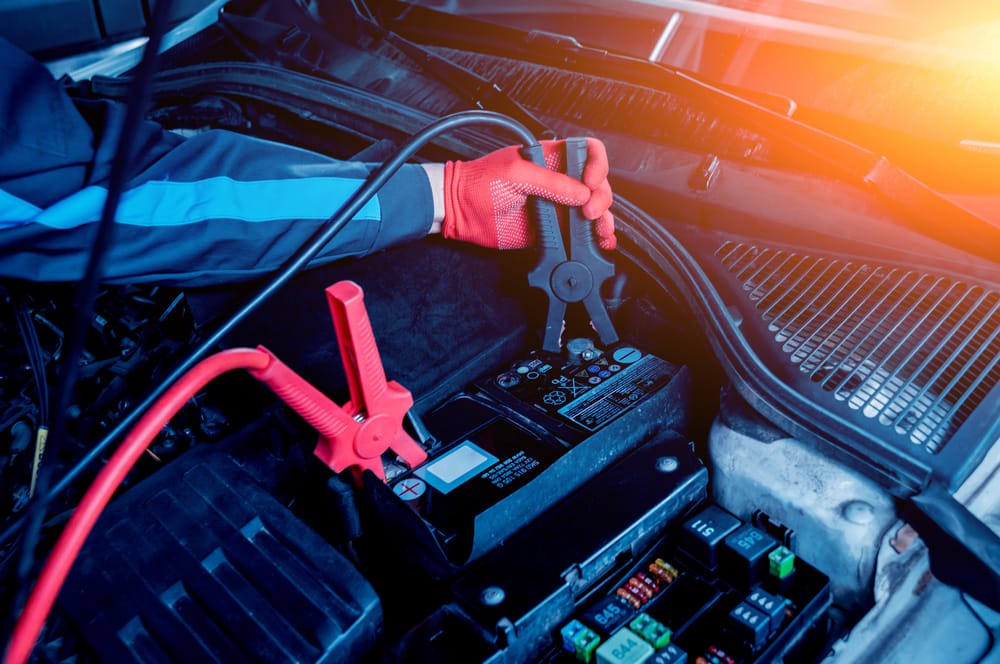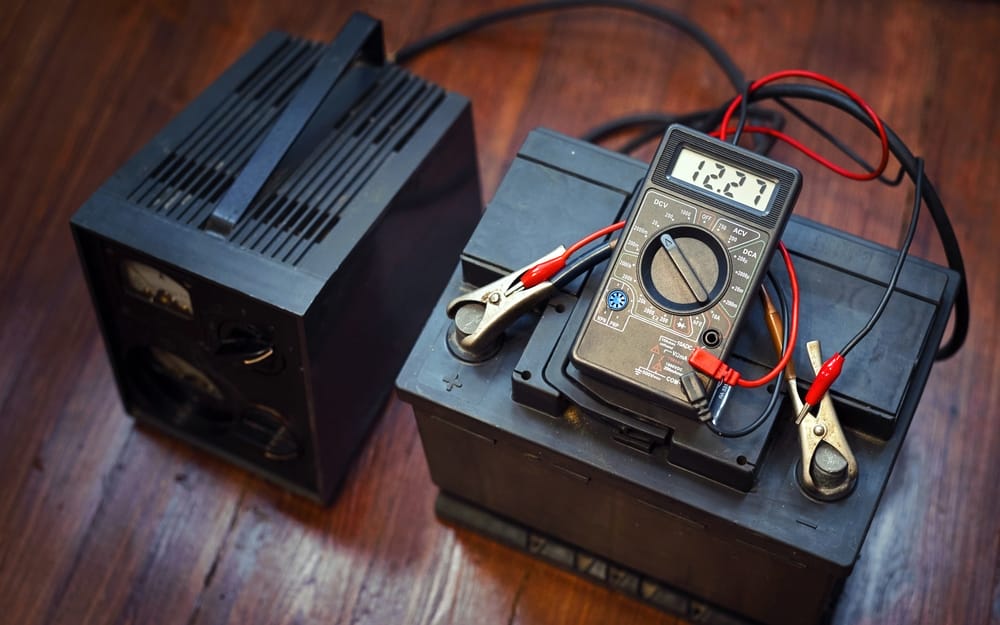
Every car owner has dealt with a low or dead battery at some point. The
hassle of disconnecting it to get it recharged makes you wonder — can you
charge your car battery without disconnecting it?
Yes, you can recharge your car battery without disconnecting it. It is
safe, especially when you are using a smart charger. But even with a
traditional charger, you can recharge your battery while it is
connected to the car, but you have to turn it off in a timely manner;
otherwise, it will result in overcharging.
Below we'll go over the things you need to consider before charging a
battery without disconnecting it.
 Charging a car battery while it is still connected to a car is ok.
Charging a car battery while it is still connected to a car is ok.
Do You Need To Unplug Car Battery To Charge?
No, you don't necessarily need to unplug a car battery to charge.
Charging the battery while connected to the car does not damage its
electrical system. But overcharging a battery while connected to the
car can cause severe damage.
When a battery overcharges, it goes through electrolysis, heats up, and
boils your battery fluid.
Now, if your battery is connected to the car when this happens, it can
forward a damaging amount of current to your electronics.
Also, the battery fluid boiling over can damage the engine compartment.
You can safely use a smart charger to recharge your battery without
disconnecting it.
On the flip side, you should use a regular charger when the battery is
disconnected.
Let's look at both chargers in more detail to understand why.
Smart Charger
Modern smart chargers are mini-computers that monitor and regulate the
entire charging process.
With these chargers, you can charge your battery while connected to your
car without fearing frying your electronics.
These chargers are programmed to provide the proper amount of current in
every phase of the charging process.
It provides a supply of current that the battery can absorb.
When the battery is low, it can absorb a lot of charge, so the smart
charger supplies it.
But when the battery is almost full, this sophisticated device holds some
amps back, supplying only the amount that the battery can take.
Once fully charged, these chargers either turn themselves off or switch
into maintenance or float mode to prevent overcharging.
Regular Charger
Unlike smart car battery chargers, regular chargers don't have a computer
controlling the amount of charge they send out.
These chargers cannot sense the number of amps the battery can accept and
will continue to deliver amps even if the battery has already been charged.
So if you don't unplug or turn them off in time, there is a solid chance of
battery overcharging.
So, if you are using a regular charger to charge your battery, it's best to
disconnect it from the car first. Plus, you should also monitor the
charging process for safety purposes.
 Charging a car battery that is disconnected from the car.
Charging a car battery that is disconnected from the car.
Is It OK To Charge A Car Battery While Connected?
Yes, it is OK to charge a car battery while connected. The charging
procedure itself is not damaging to the car. It is the overcharging of
a car battery that can cause damage.
That said, you should still practice caution, as when the battery is
connected to the car, there is still a chance of sparks happening.
That's why you should take some precautions to charge your battery safely.
We go over them below:
Wear Your Personal Protection Equipment (PPE)
Besides keeping you safe from getting a shock, gloves also prevent you from
burning yourself.
As it charges, the battery can become too hot that you won't be able to
handle it with bare hands.
You should also wear goggles when charging batteries. The fumes a charging
battery gives off can also irritate your eyes. These fumes contain tiny
droplets of sulphuric acid that can cause severe irritation around your
eyes.
In the event of an explosion, your gloves and goggles will protect you from
the battery acid.
Inspect The Battery
The next thing you should do is inspect the battery for any sign of damage.
Make sure it does not have any cracks.
Charging a leaking or cracked battery can ignite the volatile gases
escaping from it and cause it to explode.
If you spot any signs of damage, it's best to replace the battery rather
than recharge it.
Check The Charger's Voltage
The power supply to your vehicle's battery should never increase more than
14.7 volts at any point during the charging process. This is easy to
maintain because all car chargers, jump starters, and battery maintainers
are designed to stay below this benchmark.
Charge In A Ventilated Area
As the battery charges, it releases hydrogen gas. The gas is explosive if
it collects at a certain concentration. Charging in an airy room allows the
gas to escape safely into the atmosphere.
 Charging a connected car battery.
Charging a connected car battery.
What Is The Proper Way To Charge A Car Battery?
Charging a battery is a relatively simple process that anyone can safely do
by following these steps:
-
Use The Right Charger
: You should choose either a smart charger or a trickle charger, which
charges your car battery at a slow, steady speed. Yes, it takes time,
but the charge holds for longer.
-
Clean The Battery Terminals
: Prepare the battery terminals to receive charge by cleaning the
whitish powder covering them. This powder is dried sulphuric acid that
can burn your skin upon contact. Use sandpaper to scrape it off. You
can also apply baking soda and wipe the terminals with a wet cloth.
-
Remove The Cell Caps:
Your battery may have a series of small caps either on the very top or
under a yellow peelable strip. They are called cell caps and must be
removed before starting to charge because a car battery releases gases
as it charges. Not removing the caps will prevent the gaseous
byproducts from escaping into the atmosphere.
-
Connect The Charger Cables:
The battery charger has two cables — a red one for the positive
terminal and a black one for the negative terminal. Attach the cables
to their respective terminals. Make sure that your car is turned off
before you connect the cables.
-
Turn The Charger On
: Once you have connected the charging cables to both terminals, plug
the battery charger into an electrical outlet. Turn on the power supply
and leave the battery to charge.
-
Monitor The Charging Process:
If you are using a regular charger, you must regularly check the
battery voltage level because these models have no safety mechanism to
prevent overcharging. With smart chargers, this is not a problem
because they regulate the electric supply according to what the battery
needs.
-
Turn Off And Disconnect The Charger:
Once the battery is fully charged, you can turn off and disconnect the
charger.
Do You Hook Positive Or Negative Up First?
Every battery has two terminals - negative and positive.
When connecting a charger for charging a battery, you should always
connect the positive terminal first.
The negative terminal connects to the car's chassis, which is grounded.
Hooking up the negative terminal first creates an open circuit between the
chassis and the battery.
When you connect the positive terminal afterward, it completes the circuit,
letting out sparks.
Besides being shocking, the sudden surge can also short the battery or
other components of your vehicle's electrical system.
The process reverses when you disconnect the charger or battery.
You disconnect the negative terminal before disconnecting the positive
terminal. Doing so breaks the circuit, making it safe to disconnect the
positive one.
How Long Does It Take To Fully Charge A Car Battery?
It depends upon the size of the car battery and the charger's power
output. For example, a normal-sized car battery typically takes about
two to four hours to charge with a 20-ampere charger fully. But if you
use a four-ampere charger, it will jump up to 12 hours or more.
To charge a dead battery that was jump-started usually takes between 30 to 60 minutes while driving, and idling often takes 90 minutes or more to charge the battery.
An average car battery is rated at around 52 Ah. The most common power
output for car battery chargers is 4 amperes. So, it will take at least 12
hours to go from dead to fully loaded.
If you want your battery to charge quickly, you should choose a charger
with a high amperage. For example, a 20-ampere car charger will fully
charge your battery in as little as two hours.
A low-ampere car charger charges your battery slowly, so it will take a
long time to charge your battery fully. Therefore, they are a better choice
for maintenance charging.
Conclusion
You can charge your car battery while it is still connected to the vehicle
if you follow the charger manufacturer's safe operating procedures as laid
out in their operating manual.
A smart car battery charger is the best choice for charging the battery
without disconnecting.
It regulates the current flow to ensure the battery gets the exact amount
of current it needs.
There is no danger of overcharging when smart chargers are involved because
they regulate the electrical flow according to your battery's needs.
It would be best always to exercise caution when working with car
batteries. This involves wearing safety gear and being careful while
handling the battery.